Category Archives: 12. Body
Bolt types Spare Wheel Clamp
Two Bolt types for Spare Wheel Clamp
There are two types of bolts to clamp down a wheel in the boot of the XK: one suited for disc wheels and one for wire wheels. The bolt for the disc wheel is coded BD6420 and has dimensions ¾ x 6¾ inch or 19 x 171mm (and not 11/16 x 8 9/16 inch or 17½ x 217½ mm as mentioned by Porter). The bolt for the wire wheel is coded BD9583 and has dimensions ¾ x 8¾ inch or 19 x 222 mm.
The disc wheel version is also used on all saloons of that era and they seem to be better available than those for the wire wheel version. It is possible to modify the disc wheel version to the (longer) one suited for the wire wheel. A lathe, however, is required for this operation.
Modification of Disc wheel Bolt BD6420 to Wire Wheel Bolt BD9583
It is possible to modify the spare wheel bolt of the disc wheel to one for the wire wheel. Follow these steps:
Wilmot Breeden locks and (Union) keys.
Introduction.
Jaguar used Wilmot-Breeden locks and barrels on all their XK types. Wilmot-Breeden keys are branded “Union”. The following gives an overview of the history of Wilmot-Breeden and the details of the applied barrel versions for the Jaguar XK (140).
History
Starting in 1932, Ford UK began to use “MRN” series keys, which has codes ranging from 01 to 50. Other car brands also applied Wilmot Breeden locking systems. Jaguar in the post-war era, was one of them. These codes were used through 1949, but as automotive production increased, they needed more codes to go around. Jaguar applied the FNR series as well, in addition to the MRN.
Beginning 1949 the “FA” code was introduced, which features codes from 501-625. These codes were widely used from 1949 until August 1959.
In November 1955, another key code appeared, this time a “FP” code, which saw numbers ranging from 626-750.
Key codes can be found either on the face of the ignition switch, stem of the door handle, or on the lock barrel itself. However, barrels, door handles or even ignition switches, could have been changed to another key code at any time.
Original keys were made by Union / Wilmot Breeden.
There are many different locking barrels used: separate versions exist for door, ignition, boot lid, petrol lid and glove box. Each of these barrels is different in length and overall design, but they do (or may) share the same keys.
Wilmot Breeden Key codes and Year of introduction
- 1932 MRN 01 through MRN 50
- 1945? FNR 01 through FNR 25 (unique Jaguar?)
- 1949 FA 501 through FA 625
- 1955 FP 626 through FP 750
- FR 751 through FR 875
- 1960? FS 876 through FS 955
- FK 876 through FK 955
- FT 101 through FT 225
- NH 2001 through NH 3000
- FR 01 through FR 1080
- EJR 01 through 50
The barrel numbers are shown on the face of the ignition switch on early cars. The numbers were also stamped on the glove box housing, and the boot handle stem. On later cars, the original owner received a metal tag with the key number and the number was no longer stamped on the ignition switch housing to prevent that a spare key could be easily cut.
Survey of Wilmot Breeden locking barrels for XKs
Wilmot Breeden locking barrels for Jaguar XK 140 FHC
Ignition lock barrel Door & Boot lock barrel
Petrol filler lid lock barrel Cubby box lock barrel
 New locks by Weston Body Hardware (Left to Right): Petrol filler, 2 x Door/boot, Ignition
New locks by Weston Body Hardware (Left to Right): Petrol filler, 2 x Door/boot, Ignition
Key numbers and types for Jaguar XK 140
- Door lock FA round head
- Petrol filler FA round head
- Ignition lock FA round head
- Boot lock FNR rectangular head
- Cubby box FNR rectangular head
Examples of Wilmot Breeden Keys
- Top Left: FA & FNR Round
- Top Right: FA Rectangular head shape
- Bottom Left: FP Round left
- Bottom Right: FP Rectangular head shape.
Wilmot Breeden lock barrel principle
Every lock consists of 5 brass tongues composed of three different dimensions, corresponding to the cuts made in the key. A deep cut in the key corresponds with a higher remaining part in the tongue (see photo below). The overall distance over the 5 tongues is 3/8 “ meaning each tongue is spaced at 5/32” from the other.
High Low Low High High
Jaguar glove box lock
Jaguar glove box lock with key code number stamped on the base of the lock.
Jaguar Identification or Chassis Plates
Overview of Jaguar Chassis Plates used from 1946 to 1974
Jaguar used various types of Chassis (or Identification) Plates in the post WW2 period. The changes in dimension and lay-out of the plates were mostly the result of changes in available space when new models were introduced, but also due to changing brand names of lubricant suppliers or their respective products.
When focusing on the changes related to Chassis Plates we may conclude that the most apparent change relates to size and orientation of the plates in 1948. In the years before a smaller brass plate (Type A, 3½ x 4″) was vertically positioned containing relevant car data and accompanied by a similarly sized plate containing lubricant recommendations.
From the launch of the XK 120 in 1948 the plates were larger and had a “horizontal format” with both car data and lubricant recommendations combined on one plate. The initial size of this plate (Type B, 6½ x 4¼”) as used for the Jaguar Mk V, was apparently too large as it was reduced in October 1949 (Type C, 5¾ x 3¾”).
This then became the standard format for over a decade, with only a change-over from brass to aluminium in 1957.
| Type No | Dimension | Material | Used on | Year |
| TYPE A.1 | 3½ x 4″ | brass | Mk IV | 1946 |
| TYPE A.2 | 3½ x 4″ | brass | Mk IV | – |
| TYPE A.3 | 3½ x 4″ | brass | Mk IV | – |
| TYPE A.4 | 3½ x 4″ | brass | Mk IV and very early Mk V | – |
| TYPE B.1 | 6½ x 4¼” | brass | Mk V, very early XK 120 | 1948 |
| TYPE C.1 | 5¾ x 3¾” | brass | XK 120 | From October 1949 |
| TYPE C.2 | 5¾ x 3¾” | brass | XK 120 | From March 1952 |
| TYPE C.3 | 5¾ x 3¾” | brass | XK 120 | From August 1952 |
| TYPE C.4 | 5¾ x 3¾” | brass | XK 120/XK 140 Manual | From October 1953 |
| TYPE C.5 | 5¾ x 3¾” | brass | XK 140 Auto | 1954 – 1957 |
| TYPE D.1 | 5¾ x 3¾” | alu | XK 150 Manual | 1957 – 1960 |
| TYPE D.2 | 5¾ x 3¾” | alu | XK 150 Auto | 1957 – 1960 |
| TYPE D.3 | 5¾ x 3¾” | alu | XK 140 Manual | only 2nd half 1957 |
| TYPE D.4 | 5¾ x 3¾” | alu | 4XK 150 Auto | only 2nd half 1957 |
| TYPE E.1 | 6½ x 3¾“ | alu | 1961? | |
| TYPE E.2 | 6½ x 3¾“ | alu | ||
| TYPE E.3 | 6½ x 3¾“ | alu | ||
| TYPE E.4 | 6 ½ x 3¾“ | alu | ||
| TYPE E.5 | 6 ½ x 3¾“ | alu | ||
| TYPE E.6 | 6½ x 3¾“ | alu | ||
| TYPE E.7 | 6½ x 3¾“ | alu | ||
| TYPE E.8 | 6½ x 3¾“ | alu | ||
| TYPE E.9 | 6½ x 3¾“ | alu |
Type A plates on Jaguar Mk IV

 Type A4. (?)
Type A4. (?)
Type A plate on a 1948 Mk IV. Plate dimension: 3½ x 4″ . May also have been used on very early Mk V cars. Each of the 3 available engines had a specific plate. The lay-out shows only fields for CHASSIS No, ENGINE No and BODY No and is vertically oriented; all later plates have a horizontal orientation. There may have been 4 text variations for this plate (indicated with A1. to A4.) The recommendations for LUBRICANTS are shown on an identically sized plate next to the Chassis plate: VACUUM, WAKEFIELD, SHELL, ESSOLUBE and PRICE’S are mentioned here.
Type B plates on Jaguar Mk V
This new Chassis Plate measures 6½ x 4¼”, made of brass and plated with nickel. The lay-out has now 4 fields for CHASSIS No, BODY No, ENGINE No and GEARBOX No. The recommendations for LUBRICANTS remained unchanged: VACUUM, WAKEFIELD, SHELL, ESSOLUBE and PRICE’S, but an additional column has been added to show the S.A.E. viscosity. The recommendation from PRICE’S for the WHEEL HUBS was blank. To indicate the VALVE CLEARANCE two new fields have been created to be stamped per car type.
The overall lay-out was the basis for the later Type C plates.
Note: The Mk V manual contains one photo of a car with the smaller ID plate from the Mk IV era.
![clip_image002[4] clip_image002[4]](https://www.bobine.nl/jaguar/wp-content/uploads/2013/05/clip_image0024_thumb.jpg) Type B1
Type B1
Type B plates on Jaguar XK 120 (very early examples)
See data under Mk V. The same plate (Type B1) was used for a number of early XK 120 OTS versions.
Type C plates on Jaguar XK 120
Type C plates were identical to Type B plates but smaller in dimension. Four different Identification plates have been used over the life of the XK 120: C1 to C 4 (with B1 as the fifth variation for the very first XK 120’s).
The first plate (Type C1) showed a blank box for Price’s recommendation for Wheel Hubs lubrication, as was the case with the Type B plate.
![clip_image002[6] clip_image002[6]](https://www.bobine.nl/jaguar/wp-content/uploads/2013/05/clip_image0026_thumb.jpg) Type C1.
Type C1.
This was corrected with a temporary solution by riveting an “add-on” plate over the bottom two rows, now showing BELMOLINE H.M.P. on the empty space. This version (Type C2, see here under) lasted for about 6 months from March to August 1952.
![clip_image004[4] clip_image004[4]](https://www.bobine.nl/jaguar/wp-content/uploads/2013/05/clip_image0044_thumb.jpg) Type C2.
Type C2.
In August 1952 the” add-on” plate was replaced by a new plate (Type C3) fully identical to the Type C1 plate but now with BELMOLINE H.M.P. on the former empty space .
![clip_image006[4] clip_image006[4]](https://www.bobine.nl/jaguar/wp-content/uploads/2013/05/clip_image0064_thumb.jpg) Type C 3.
Type C 3.
Note: also the Jaguar C-type used Chassis Plate Type 3 (see below).
 C-type chassis plate
C-type chassis plate
Final change in Type C plates on Jaguar XK 120 and 140.
In October 1953 a number of modifications were made to the text of the Chassis Plate (Type C 4.). The most important modification was the change from ESSOLUBE to ESSO and BELMOLINE H.M.P. becoming now ENERGREASE No 3. These plates are otherwise easily recognisable by the text change in the VALVE CLEARANCE row, reading INLET and EXHAUST instead of the former abbreviations INL. and EXH..
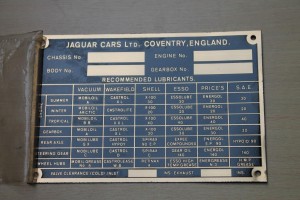 Type C4 (NOS!!)
Type C4 (NOS!!)
Addition of “Automatic” Type C plates on Jaguar XK 140.
From January 1956 onwards an Automatic Transmission was offered for the XK 140, necessitating a change in the lay-out of the Plates. STEERING GEAR and WHEEL HUBS had been combined in one field and the lower row remained blank
 Type C5
Type C5
Type D plates on Jaguar XK 150
This type was introduced in 1957 on the XK 150 and was made of Aluminium instead of Brass as had been the material for all previous types.
The basic lay-out was in line with the Type C5 plates, meaning STEERING GEAR and WHEEL HUBS had been combined in one field and the lower row remained blank.
In addition some Lubricant suppliers had changed name as well as the names for oils and greases themselves. The changes were: MOBIL instead of VACUUM and B.P. instead of PRICE’S.
![clip_image002[8] clip_image002[8]](https://www.bobine.nl/jaguar/wp-content/uploads/2013/05/clip_image0028_thumb.jpg) Type D1
Type D1
![clip_image004[6] clip_image004[6]](https://www.bobine.nl/jaguar/wp-content/uploads/2013/05/clip_image0046_thumb.jpg) Type D2.
Type D2.
Plate for Automatic Transmission has same lay-out as Type C5 except for MOBIL and B.P.
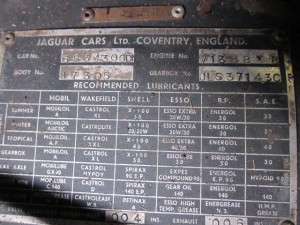
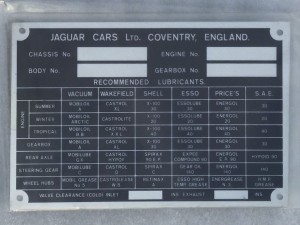 Type D3 with NOS version at the right
Type D3 with NOS version at the right
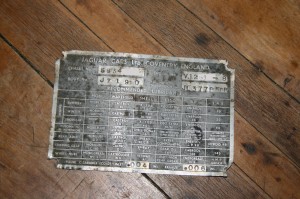 Type D4
Type D4
For a short period a few XK 150’s (without any logical sequence) manufactured from June to November 1957 had a different plate: the row for STEERING GEAR and WHEEL HUBS was no longer combined in one field and the bottom row was now in use. This for both manual (Type D3 plate) and automatic cars (Type D4 plate). It is unclear why this temporary solution had been implemented.
Type E plates on Jaguar E-type
Early E-Types continued the XK150 D style chassis plate. It’s not exactly clear when Jaguar switched over to a new plate but possibly the first 500 cars (with outside bonnet locks) may have carried the D type of chassis plate.
The chassis plate that followed for the E-type was a plate of larger dimension (6½ x 3¾“), which is about ¾ inch wider than the preceding types. The change-over to a larger plate may have been caused by the introduction of 7 rows for lubricant manufacturers instead of 5 plus 1 column for the SAE type of the lubricant. The new row reads: MOBIL. CASTROL, SHELL, ESSO, B.P., DUCKHAM, REGENT CALTEX TEXACO.
Note the little space between TEX and ACO on some plates.
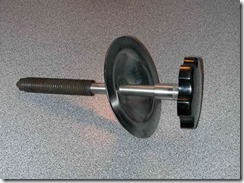
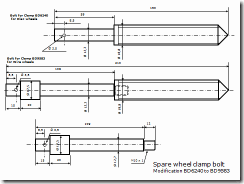

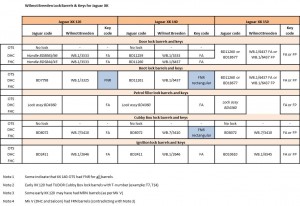








![clip_image006[6] clip_image006[6]](https://www.bobine.nl/jaguar/wp-content/uploads/2013/05/clip_image0066_thumb.jpg)